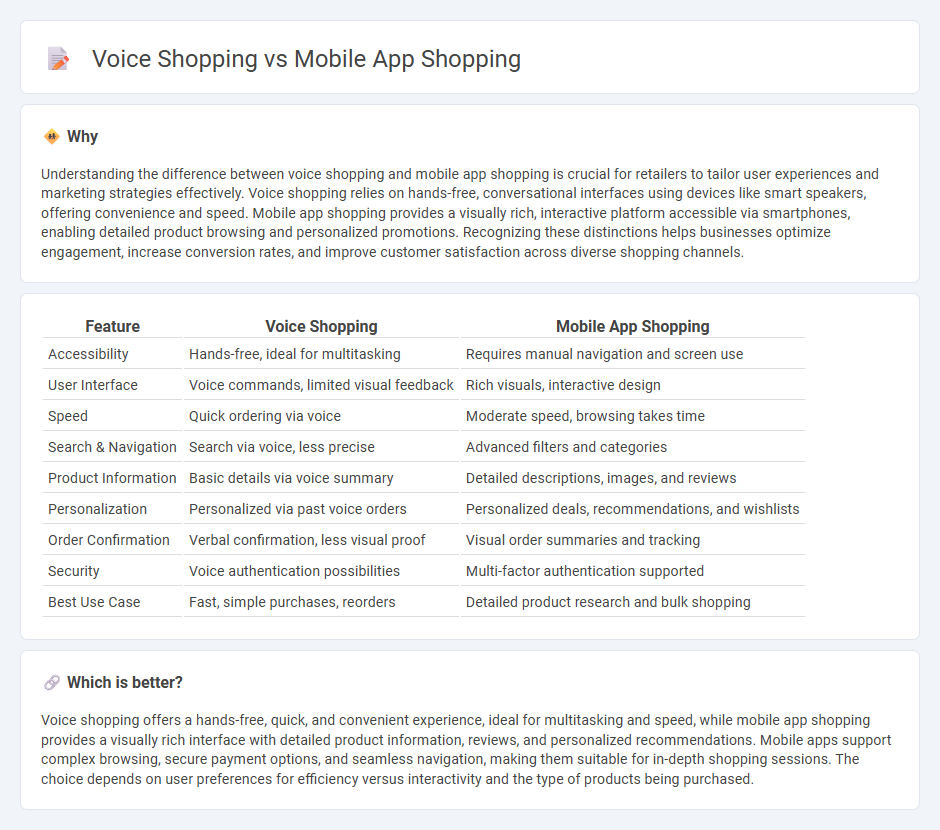
Voice shopping leverages natural language processing to enable consumers to make purchases through smart speakers and virtual assistants, offering a hands-free, efficient retail experience. Mobile app shopping provides a visually rich interface with personalized recommendations, seamless navigation, and integrated payment options, catering to on-the-go consumers. Explore the evolving dynamics of retail by discovering how voice and mobile app shopping transform consumer behavior and sales strategies.
Why it is important
Understanding the difference between voice shopping and mobile app shopping is crucial for retailers to tailor user experiences and marketing strategies effectively. Voice shopping relies on hands-free, conversational interfaces using devices like smart speakers, offering convenience and speed. Mobile app shopping provides a visually rich, interactive platform accessible via smartphones, enabling detailed product browsing and personalized promotions. Recognizing these distinctions helps businesses optimize engagement, increase conversion rates, and improve customer satisfaction across diverse shopping channels.
Comparison Table
| Feature | Voice Shopping | Mobile App Shopping |
|---|---|---|
| Accessibility | Hands-free, ideal for multitasking | Requires manual navigation and screen use |
| User Interface | Voice commands, limited visual feedback | Rich visuals, interactive design |
| Speed | Quick ordering via voice | Moderate speed, browsing takes time |
| Search & Navigation | Search via voice, less precise | Advanced filters and categories |
| Product Information | Basic details via voice summary | Detailed descriptions, images, and reviews |
| Personalization | Personalized via past voice orders | Personalized deals, recommendations, and wishlists |
| Order Confirmation | Verbal confirmation, less visual proof | Visual order summaries and tracking |
| Security | Voice authentication possibilities | Multi-factor authentication supported |
| Best Use Case | Fast, simple purchases, reorders | Detailed product research and bulk shopping |
Which is better?
Voice shopping offers a hands-free, quick, and convenient experience, ideal for multitasking and speed, while mobile app shopping provides a visually rich interface with detailed product information, reviews, and personalized recommendations. Mobile apps support complex browsing, secure payment options, and seamless navigation, making them suitable for in-depth shopping sessions. The choice depends on user preferences for efficiency versus interactivity and the type of products being purchased.
Connection
Voice shopping enhances mobile app shopping by enabling hands-free, quick searches and purchases through integrated voice assistants on smartphones. Mobile apps leverage voice recognition technology to improve user experience, streamline navigation, and provide personalized product recommendations. This seamless interaction boosts customer engagement and increases conversion rates in the retail sector.
Key Terms
User Interface (UI)
Mobile app shopping offers a visually rich and interactive UI with detailed product images, customizable filters, and intuitive touch controls, enhancing user engagement through tactile feedback and clear navigation paths. Voice shopping relies on auditory UI, prioritizing natural language processing and simple command structures to facilitate hands-free, quick transactions but may limit detailed product browsing and comparison. Explore the distinct UI designs and user experience advantages unique to mobile and voice shopping to optimize your e-commerce strategy.
Conversational Commerce
Conversational commerce leverages voice assistants and chatbots to create seamless shopping experiences beyond traditional mobile app interfaces, enabling users to make purchases through natural language interactions. Voice shopping enhances convenience by allowing hands-free, quick transactions, while mobile app shopping offers visual browsing and detailed product information. Explore how integrating voice technologies with mobile platforms revolutionizes customer engagement and boosts online sales.
Personalization
Mobile app shopping leverages user data and browsing history to deliver highly personalized product recommendations, tailored promotions, and customized interfaces, enhancing the overall user experience. Voice shopping relies on natural language processing and user preferences to expedite purchasing through simple voice commands but currently offers less precise personalization compared to apps. Explore how advanced AI is bridging the gap between mobile and voice shopping personalization for a seamless consumer journey.
Source and External Links
14 Best Shopping Apps of 2025 | Sprout Social - Highlights the rise of mobile commerce with top shopping apps like Amazon, specialized for clothing, groceries, and cars, offering features like personalized ads, price comparisons, and fast deliveries.
15 Best Shopping Apps in 2025 - MobiLoud - Lists the most popular shopping apps for iOS and Android platforms, including Temu, Shein, Amazon, Walmart, and others, reflecting user preferences and app store rankings.
Shop: All your favorite brands - Apps on Google Play - Describes the Shop app by Shopify, focusing on seamless shopping experiences with features like one-tap checkout, personalized recommendations, Shop Cash rewards, and real-time package tracking.
 dowidth.com
dowidth.com